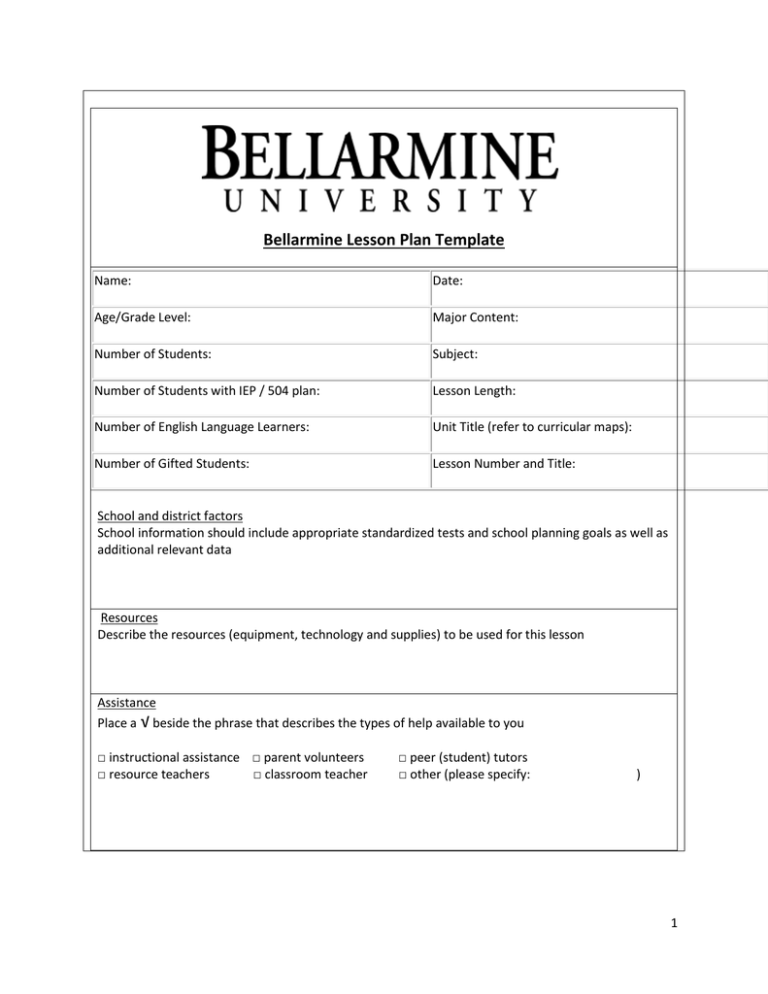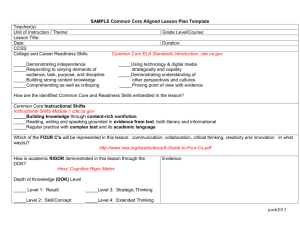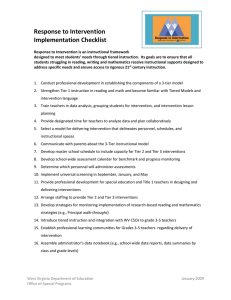Bellarmine Lesson Plan Template
advertisement

Bellarmine Lesson Plan Template Name: Date: Age/Grade Level: Major Content: Number of Students: Subject: Number of Students with IEP / 504 plan: Lesson Length: Number of English Language Learners: Unit Title (refer to curricular maps): Number of Gifted Students: Lesson Number and Title: School and district factors School information should include appropriate standardized tests and school planning goals as well as additional relevant data Resources Describe the resources (equipment, technology and supplies) to be used for this lesson Assistance Place a √ beside the phrase that describes the types of help available to you □ instructional assistance □ parent volunteers □ resource teachers □ classroom teacher □ peer (student) tutors □ other (please specify: ) 1 Student Differences Indicate the number of students in each category below and briefly describe the needs of students in the categories noted ESL: Title I: # with IEPs: Gifted: # with 504 modifications: Other: Description of needs: Response to Intervention Tier 1 Interventions: Tier 2 Interventions: Tier 3 Interventions: Student Diversity Please describe any language, cultural and/or achievement/developmental level differences that create instructional concerns in your class: Patterns of Achievement Indicate the number of students for each pattern of achievement: □ Below grade level □ At grade level □ Above grade level Other classroom conditions Describe other classroom conditions (if any) including student demographics that have implications for teaching and what might be observed in your classroom: 2 Implications for Instruction Determine ways you will address individual needs based on identified student differences. Context for lesson 1. Explain how this lesson relates to the unit of study or your broad goals for teaching the topic: 2. Describe the students’ prior knowledge of the content of the lesson: 3. Identify critical student characteristics or attributes that affect student learning: 4. Describe culturally responsive teaching strategies designed to address student characteristics: Learning Objective(s) OR Learning Target(s) 1. Number each objective or target 2. Objectives/targets are to be student oriented, observable, measurable, varied in complexity and specify the content knowledge and/or skills that students will demonstrate at the end of this lesson Connections to Standards Connect your lesson objectives/learning targets to appropriate National and/or Kentucky curricular standards. Use no more than two or three connections. Explain the way(s) that each objective/target is related to National and/or Kentucky curricular standards. 3 Assessment Plan Using the tabular format below, describe the way each learning objective/target will be assessed formatively to determine student progress and modify instruction when necessary. Describe any summative assessment to be used as a part of this lesson. Include copies of the assessment instruments and scoring criteria or rubrics. Objective / Assessment Organizer Objective Number Type of Assessment Description of Assessment Depth of Knowledge Level Adaptations and/or Accommodations DOK 1 Recall DOK 2 Comprehension Objective # For example, Open response, Formative OR True False, Matching, Exit DOK 3 Summative Slip, Anticipatory Guide, Application/Analysis/Synthesis Document Based Question DOK 4 Evaluation For example, differentiated readability, guided notes, assistive technology, extra time for two students with IEP's Objective # Objective # Resources, media and technology Include copies of the specific instructional materials used in the lesson List equipment needed for the lesson. If appropriate, list technology resources for the lesson including hardware, software and Internet URLs, and be sure to cite the sources used to develop this lesson. * If internet resources were used to develop this lesson cite those specific websites and/or materials in this section. Procedures Chronologically list each instructional activity. Specify for each Estimated time for each activity Student role in the activity 4 Formative Assessment as the assessments occur during the activity Identify strategies within the activity that demonstrate differentiated instruction Indicate approaches to activate students’ prior knowledge Lesson Analysis and Reflection ANALYZE AND EVALUATE YOUR LESSON WITHIN TWO DAYS OF TEACHING THE LESSON. 1. Explain the way you determined the levels of student performance for each learning objective/target. Attach rubrics, criteria or cut scores used on this determination. 2. Go back to each learning objective/target. Identify specific deficits or accomplishments that the groups of students achieved for each learning objective/target. Learning Objective/Learning Target # Names of Students Below Criteria Names of Students Met Criteria 3. Reflect on the following: a. Identify patterns or trends in student performance levels. b. Group students based on student performance levels. 4. How can you now use the patterns and trends for planning the next lesson? a. For each category of students, plan specific differentiated instructional activities to move students forward. b. Design corrective activities for reteaching the learning objective(s)/target(s) for students who did not meet the learning objective(s)/target(s). c. Design enrichment activities to extend learning for students who did meet the learning objective(s)/target(s). Student Group Corrective Activity Enrichment/Extension Activity 5 5. Describe the way(s) you plan to report or plan to communicate learning results to students and parents. 6










